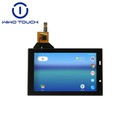A major drawback of capacitive touch sensors is their susceptibility to noise and interference. Engineers must therefore ensure that sources of interference are eliminated or mitigated wherever possible. For example, fluctuations in the power supply can easily inject noise into the sensor itself, especially high-frequency noise caused by switching power supplies and microcontroller operation. Therefore, power supplies and microcontrollers must have adequate decoupling and low-pass filters. Apply noise reduction filters to the touch screen circuit. These filters can effectively block high-frequency noise signals without affecting the basic capacitance of the touch screen. The filters are usually installed in the controller circuitry of the touchscreen and can be easily added to an existing design.
Another particularly troublesome source of interference is external electromagnetic interference (EMI), since capacitive touch sensors are large boards that act as antennas. One solution to this problem is to implement a grounding mechanism. By grounding the screen frame or using a shielding film between the screen and the device, the effects of EMI and RFI can be reduced. Grounding also stabilises the capacitance of the screen, which improves accuracy.
A third option is to use software algorithms to filter out noise and interference. Many touchscreen controllers come with built-in algorithms that effectively filter out noise and interference. The algorithm works by analysing touch signals and identifying unwanted signals, then filtering them out to ensure accurate readings.
Finally, when testing capacitive touch screens it is best to place the screen flat on top of an insulating mat and then power up the screen for testing, this way you can effectively solve the noise and interference problem.
Certification: An EMI shielding capacitive touch screen





